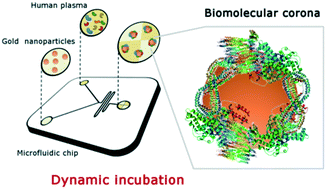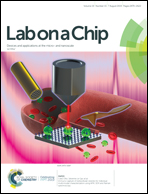The biomolecular corona of gold nanoparticles in a controlled microfluidic environment†
Abstract
Nanoparticles (NPs) exposed to biological media are coated by proteins and other biomolecules forming a biomolecular corona (BC) on the particle surface. Recent studies have shown that shear stress as that created by laminar fluid flow generates more complex coronas with systematic changes in composition with respect to counterparts formed under static incubation. However, in most studies reported so far, dynamic environments have been produced by peristaltic pumps and comparing experimental results appears challenging. On the other side, generating shear stress by microfluidic devices could help to remove user variability and ensure better reproducibility of experimental data. This study was therefore aimed at exploring formation of NP-BC in a microfluidic environment. To this end, 100 nm gold nanoparticles and human plasma (HP) were used as models for nano-formulation and biological medium. We injected gold nanoparticles and HP in each of the islets of a remote-controlled microfluidic cartridge. Static incubation was used as a reference. BC-decorated NPs were thoroughly characterized by dynamic light scattering (DLS), micro-electrophoresis (ME), sodium dodecyl sulfate polyacrylamide gel electrophoresis (SDS PAGE) and nano-liquid chromatography tandem mass spectrometry (nano-LC MS/MS). By varying the incubation time from 30 s to 2.5 min we demonstrate that BC is already determined by the earliest exposure time point and does not appreciably evolve in time. DLS and ME results demonstrate that the BC formed in a microfluidic chip is thicker and more negatively charged than its counterpart formed under static incubation. SDS-PAGE and nano-LC MS/MS revealed that the incubation procedure had a major effect on BC composition. As an example, immunoglobulins are the most abundant plasma proteins of the BC generated in a microfluidic environment (relative protein abundance ∼30%), while tissue leakage proteins (relative protein abundance ∼26%) are the most enriched proteins when the BC is formed upon static incubation. Potential implications in emerging biomedical research arenas are discussed.

- This article is part of the themed collection: Lab on a Chip Recent HOT Articles


 Please wait while we load your content...
Please wait while we load your content...